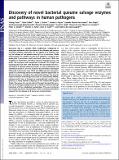Discovery of novel bacterial queuine salvage enzymes and pathways in human pathogens
Author(s)
Dedon, Peter C.
DownloadPublished version (2.106Mb)
Publisher Policy
Publisher Policy
Article is made available in accordance with the publisher's policy and may be subject to US copyright law. Please refer to the publisher's site for terms of use.
Terms of use
Metadata
Show full item recordAbstract
Queuosine (Q) is a complex tRNA modification widespread in eukaryotes and bacteria that contributes to the efficiency and accuracy of protein synthesis. Eukaryotes are not capable of Q synthesis and rely on salvage of the queuine base (q) as a Q precursor. While many bacteria are capable of Q de novo synthesis, salvage of the prokaryotic Q precursors preQ0 and preQ1 also occurs. With the exception of Escherichia coli YhhQ, shown to transport preQ0 and preQ1, the enzymes and transporters involved in Q salvage and recycling have not been well described. We discovered and characterized 2 Q salvage pathways present in many pathogenic and commensal bacteria. The first, found in the intracellular pathogen Chlamydia trachomatis, uses YhhQ and tRNA guanine transglycosylase (TGT) homologs that have changed substrate specificities to directly salvage q, mimicking the eukaryotic pathway. The second, found in bacteria from the gut flora such as Clostridioides difficile, salvages preQ1 from q through an unprecedented reaction catalyzed by a newly defined subgroup of the radical-SAM enzyme family. The source of q can be external through transport by members of the energy-coupling factor (ECF) family or internal through hydrolysis of Q by a dedicated nucleosidase. This work reinforces the concept that hosts and members of their associated microbiota compete for the salvage of Q precursors micronutrients.
Date issued
2019-09-03Department
Massachusetts Institute of Technology. Department of Biological Engineering; Massachusetts Institute of Technology. Center for Environmental Health SciencesJournal
Proceedings of the National Academy of Sciences of the United States of America
Publisher
Proceedings of the National Academy of Sciences
Citation
Yuan, Yifeng et al. "Discovery of novel bacterial queuine salvage enzymes and pathways in human pathogens." Proceedings of the National Academy of Sciences of the United States of America 116 (2019):19126-19135 © 2019 The Author(s)
Version: Final published version
ISSN
0027-8424
1091-6490
Keywords
Multidisciplinary